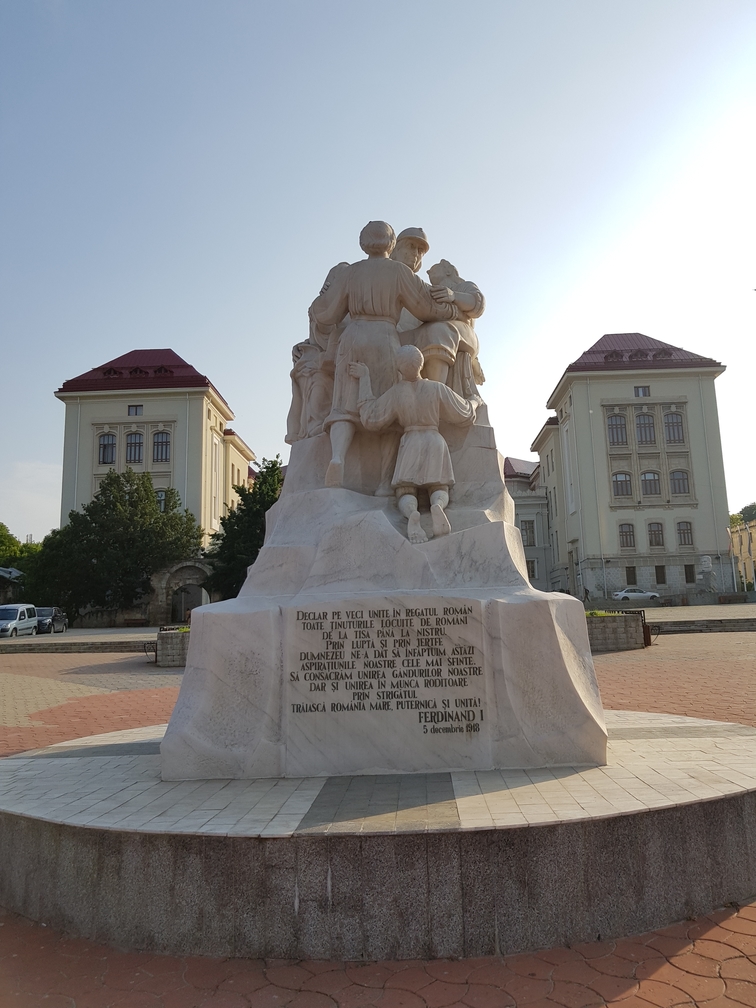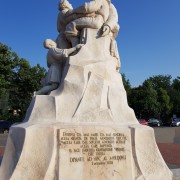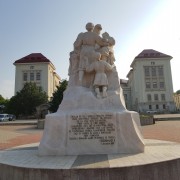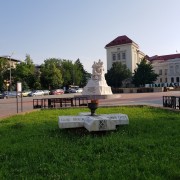Location in relation to the surroundings
The monument is located in the United Nations Square near the Grigore T. Popa University of Medicine and Pharmacy.
Text of the inscription
„Dorința cea mai mare, cea mai generală, aceea care a hrănit toate generațiile trecute, aceea care este sufletul generației actuale, aceea care, împlinită, va face fericirea generațiilor viitoare este unirea! Divanul Ad-hoc al Moldovei, 7 octombrie 1858” (The greatest and the most common desire, that which has nourished all past generations, that which is at the heart of the present generation, that which, once fulfilled, will gladden future generations, is the union! Ad hoc Divan of Moldavia, 7 October 1858)
„Unirea coroanelor lui Ștefan cel Mare și Mihai Viteazul este triumful unui principiu mare, care viază cu tărie în inimile românilor: principiul frăției românești. El ne-a salvat de la pierzanie în trecut, el ne reînvie în timpul de față, el ne va duce la bine și la mărire în viitor. Trăiască frăția românească! Trăiască principatele române!” Alexandru Ioan Cuza, 29 ianuarie 1859 (The union of the crowns of Stephen the Great and Michael the Brave is the triumph of a great principle, which lives vigorously in the hearts of Romanians: the principle of Romanian brotherhood. It has saved us from perdition in the past, it revives us at the present, it shall lead us to good things and greatness in the future. Long live the Romanian brotherhood! Long live the Romanian Principalities; Alexandru Ioan Cuza, 29 January 1859)
„Declar pe veci unite în Regatul României toate ținuturile locuite de români, de la Tisa la Nistru. Prin lupte și jertfe, Dumnezeu ne-a dat să înfăptuim astăzi aspirațiile noastre cele mai sfinte. Să consacrăm unirea gândurilor, unirea sufletelor, dar și unirea în muncă roditoare prin strigătul: Trăiască România Mare, puternică și unită! Ferdinand I, 5 decembrie 1918” (I declare that all lands inhabited by Romanians, from the Tisa to the Nistru, are forever united with the Kingdom of Romania. Through fights and sacrifices, God has allowed us to achieve today our most holy aspirations. Let us consecrate the union of thoughts, of souls, but also the union in fruitful labour by shouting: Long live Greater Romania, strong and united! Ferdinand I, 5 December 1918)
„Neamului românesc întregit și Iașului – leagănul unirilor – închin această lucrare a inimii și mâinilor mele. Olga I. Sturza. 29 mai 1927” (To the united people of Romania and to Iaşi – the cradle of unions – I offer this work of my heart and hands to you. Olga I. Sturza, 29 May 1927)
General description
The monument is made of white marble and is 5.5 meters high, symbolizing the Great Union of 1918. The base of the monument is made of stone. The words uttered by the Ad hoc Divan of Moldavia (7 October 1858), Alexandru Ioan Cuza (29 January 1859), King Ferdinand I of Romania (5 December 1918) and Olga Sturdza (29 May 1927) were engraved on the four sides of the monument. The monument includes a central piece representing Motherland, for which Queen Marie of Romania agreed to pose, as well as four other smaller pieces (representing the reunited provinces of Transylvania, Bessarabia, Bukovina and Romanians beyond the borders of the country). The provinces are depicted as three children, while, at the base of the statue, a child is kneeling in the hopes to return to his mother(land), Romania. The sculptor asked students from the Mihail Sturdza High School in Iași to pose as models for the four children figures.
Condition
Good
The circumstances of unveiling
On 8 February 1994, the Municipality of Iași decided to have the Union Monument, which Princess Olga Sturdza donated to the municipality back in 1927, redone and relocated. Between 1995 and 1999, sculptor Constantin Crengăniș rebuilt the monument based on photographs of the period, with the financial support of the Municipality of Iași. The Union Monument was placed on 1 December 1999 in Piața Națiunilor (United Nations Square). On the back side of the monument, under the words by Olga Sturdza, following words are also engraved in the plinth: „Noi am refăcut acest monument în semn de omagiu și recunoștință pentru toți cei care au luptat, luptă și vor lupta pentru întregirea și unitatea neamului românesc. Primăria Municipiului Iași. 1 Decembrie 1999. Refăcut de Constantin Crengăniș. 1995-1999.” (We had this monument redone in respect and gratitude to all those who have fought, are fighting and shall fight for the reunification and unity of the Romanian people. Municipality of Iași. 1 December 1999. Redone by Constantin Crengăniș. 1995-1999)
Later history
On 1 August 1924, Princess Olga Sturdza expressed her desire to donate a marble monument to the city. The original plan was to have the monument erected at the entrance of the palace of the great Logothete Dumitrache Cantacuzino-Paşcanu, at the end of Carol I Boulevard (Copou), where Queen Marie of Romania stayed at the time when Romanian authorities had taken refuge in Iași (1916-1918). Because of its size, however, the location was changed to the intersection of Păcurari Street and Carol I Boulevard. The works began in 1925 and the monument was finally unveiled on 29 May 1927 in the presence of Queen Marie of Romania, Princess Ileana (the daughter of King Ferdinand I) and Princess Elena (Princess Carol's wife), Prince Michael (future King Michael I of Romania). In 1947, the armistice commission ordered to have the monument in Iași dismantled. The monument symbolises the return of the Romanian provinces of Bessarabia, Transylvania and Bukovina to their Motherland.
Contemporary importance
It is an important place for celebrations of the National Day of Romania. Located in the centre of Iași, the Union Monument is one of the landmarks of the capital of Moldavia.
Publications, sources, links
Constantin Ostap, Minunea albă revine în Iași, (The White Wonder Returns to Iași) in: „Magazin istoric”, Anno XXXIV, No. 3(396), March 2000
https://ro.wikipedia.org/wiki/Monumentul_Unirii_din_Iași
http://enciclopediaromaniei.ro/wiki/Monumentul_Unirii_din_Iaşi





















